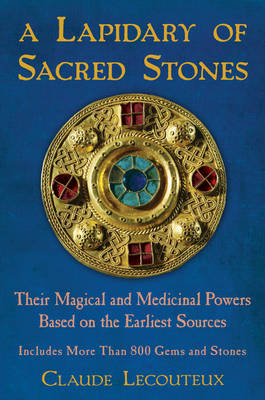
A Lapidary of Sacred Stones
Their Magical and Medicinal Powers Based on the Earliest Sources
Seiten
2012
Inner Traditions Bear and Company (Verlag)
978-1-59477-463-8 (ISBN)
Inner Traditions Bear and Company (Verlag)
978-1-59477-463-8 (ISBN)
- Titel z.Zt. nicht lieferbar
- Portofrei ab CHF 40
- Auch auf Rechnung
- Artikel merken
A comprehensive dictionary of sacred and magical gem lore that draws on the rarest source texts of Antiquity and the Middle Ages.
.
A comprehensive dictionary of sacred and magical gem lore that draws on the rarest source texts of Antiquity and the Middle Ages
• Reveals the healing and magical virtues of familiar gemstones, such as amethyst, emerald, and diamond, as well as the lore surrounding exotic stones such as astrios, a stone celebrated by ancient magicians
• Examines bezoars (stones formed in animals’ bodies) and “magnets” that attract materials other than metal
• Based on ancient Arabic, Greek, Jewish, and European sources, ranging from the observations of Pliny the Elder to extremely rare texts such as the Picatrix and Damigeron’s Virtue of Stones
Our ancestors believed stones were home to sacred beings of power, entities that if properly understood and cultivated could provide people protection from ill fortune, envy, and witchcraft; grant invisibility and other magical powers; improve memory; and heal the sick from a wide variety of diseases. These benefits could be obtained by wearing the stone on a ring, bracelet, or pendant; through massage treatments with the stone; or by reducing the gem into a powder and drinking it mixed with water or wine.
Drawing from a wealth of ancient Arabic, Greek, Jewish, and European sources--from the observations of Pliny the Elder to extremely rare texts such as the Picatrix and Damigeron’s Virtue of Stones--Claude Lecouteux provides a synthesis of all known lore for more than 800 stones. He includes such common examples as the emerald, which when engraved with the figure of a harpy holding a lamprey in its claws will banish panic and nightmares, and beryl, which when appropriately carved can summon water spirits or win its owner high renown, as well as more exotic stones such as astrios, a stone celebrated by ancient magicians and whose center glows like a star. Lecouteux also examines bezoars--stones formed in animals’ bodies--as well as “magnets” that attract materials other than iron, such as gold, flesh, cotton, or scorpions.
This comprehensive dictionary of sacred and magical gem lore, drawn from the rarest sources of Antiquity and the Middle Ages, represents a one-of-a-kind resource for gem enthusiasts and magical practitioners alike.
.
A comprehensive dictionary of sacred and magical gem lore that draws on the rarest source texts of Antiquity and the Middle Ages
• Reveals the healing and magical virtues of familiar gemstones, such as amethyst, emerald, and diamond, as well as the lore surrounding exotic stones such as astrios, a stone celebrated by ancient magicians
• Examines bezoars (stones formed in animals’ bodies) and “magnets” that attract materials other than metal
• Based on ancient Arabic, Greek, Jewish, and European sources, ranging from the observations of Pliny the Elder to extremely rare texts such as the Picatrix and Damigeron’s Virtue of Stones
Our ancestors believed stones were home to sacred beings of power, entities that if properly understood and cultivated could provide people protection from ill fortune, envy, and witchcraft; grant invisibility and other magical powers; improve memory; and heal the sick from a wide variety of diseases. These benefits could be obtained by wearing the stone on a ring, bracelet, or pendant; through massage treatments with the stone; or by reducing the gem into a powder and drinking it mixed with water or wine.
Drawing from a wealth of ancient Arabic, Greek, Jewish, and European sources--from the observations of Pliny the Elder to extremely rare texts such as the Picatrix and Damigeron’s Virtue of Stones--Claude Lecouteux provides a synthesis of all known lore for more than 800 stones. He includes such common examples as the emerald, which when engraved with the figure of a harpy holding a lamprey in its claws will banish panic and nightmares, and beryl, which when appropriately carved can summon water spirits or win its owner high renown, as well as more exotic stones such as astrios, a stone celebrated by ancient magicians and whose center glows like a star. Lecouteux also examines bezoars--stones formed in animals’ bodies--as well as “magnets” that attract materials other than iron, such as gold, flesh, cotton, or scorpions.
This comprehensive dictionary of sacred and magical gem lore, drawn from the rarest sources of Antiquity and the Middle Ages, represents a one-of-a-kind resource for gem enthusiasts and magical practitioners alike.
Claude Lecouteux is a former professor of medieval literature and civilization at the Sorbonne. He is the author of numerous books on medieval and pagan beliefs, including The Secret History of Poltergeists and Haunted Houses and The Secret History of Vampires. He lives in Paris.
Acknowledgments
Introduction: The Bones of the Earth
Dictionary of Magical and Medicinal Stones
An A to Z Guide to the Sacred Power of Gems from Antiquity to the Middle Ages
Notes
Bibliography
| Erscheint lt. Verlag | 31.1.2013 |
|---|---|
| Zusatzinfo | Includes 8-page color insert and 92 b&w illustrations |
| Verlagsort | Rochester |
| Sprache | englisch |
| Maße | 152 x 229 mm |
| Gewicht | 744 g |
| Themenwelt | Sachbuch/Ratgeber ► Gesundheit / Leben / Psychologie ► Alternative Heilverfahren |
| Sachbuch/Ratgeber ► Gesundheit / Leben / Psychologie ► Esoterik / Spiritualität | |
| ISBN-10 | 1-59477-463-3 / 1594774633 |
| ISBN-13 | 978-1-59477-463-8 / 9781594774638 |
| Zustand | Neuware |
| Informationen gemäß Produktsicherheitsverordnung (GPSR) | |
| Haben Sie eine Frage zum Produkt? |
Mehr entdecken
aus dem Bereich
aus dem Bereich
Buch | Softcover (2023)
Urban & Fischer in Elsevier (Verlag)
CHF 44,75


